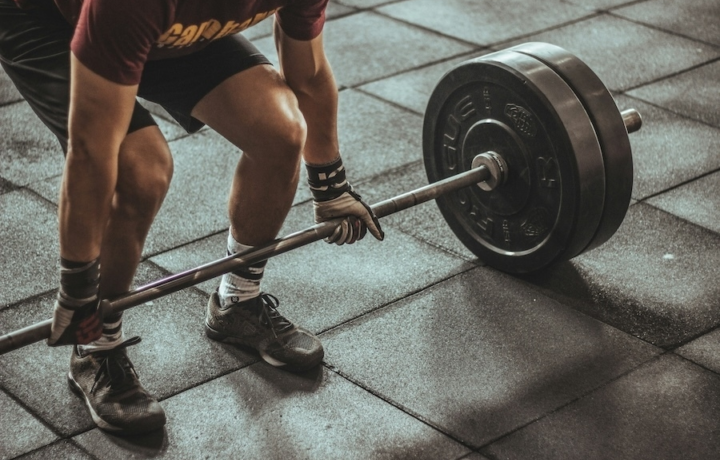Exercise
Kettlebell Sumo Deadlift

Kettlebell Sumo Deadlift
How to Perform
- Stand with your feet wider than shoulder-width apart and toes pointed outward at a 45-degree angle, with a kettlebell centered between your feet.
- Hinge at your hips and bend your knees to lower your body, maintaining a neutral spine as you reach down to grasp the kettlebell handle with both hands.
- Position your shoulders directly above or slightly behind the kettlebell, keeping your chest up and shoulder blades pulled back and down.
- Take a deep breath in, brace your core, and drive your feet into the floor as if you're trying to split the ground apart.
- Push through your heels and extend your hips and knees simultaneously to stand up, keeping the kettlebell close to your body throughout the movement.
- Exhale as you reach the top position, squeezing your glutes and maintaining a tall posture with shoulders back.
- Initiate the descent by hinging at your hips first, then bending your knees as you lower the kettlebell back to the starting position while maintaining your neutral spine.
- Control the kettlebell all the way to the floor, inhale at the bottom, and repeat the movement for the prescribed number of repetitions.
Important information
- Keep your back flat and chest up throughout the entire movement — if your back begins to round, reduce the weight or take a break.
- Make sure your knees track in line with your toes and don't collapse inward during the lift.
- Focus on pushing the floor away rather than pulling the weight up to maintain proper mechanics and engage the right muscles.
- If you experience lower back discomfort, check your form or consider starting with a lighter kettlebell until you master the movement pattern.

Kettlebell Sumo Deadlift
Exercise Details
Primary Muscles
Muscle Groups
Mechanic
Risk Areas
Built for progress
Take the guesswork out of training
Create personalized AI-powered workout plans that evolve with you. Train smarter, track every rep and keep moving forward, one workout at a time.






The Kettlebell Sumo Deadlift stands as a powerful compound movement that deserves a prominent place in any intermediate lifter's arsenal. This dynamic exercise primarily targets the glutes, hamstrings, and quadriceps, creating a comprehensive lower body stimulus that few movements can match. The wide stance variation increases inner thigh engagement while maintaining the posterior chain development that makes deadlift variations so effective.
When incorporated into bodybuilding routines, the Kettlebell Sumo Deadlift allows for precise muscle development with less spinal loading than traditional barbell deadlifts. The kettlebell's positioning naturally enforces proper form, keeping the weight centered and encouraging lifters to maintain an upright torso. Many physique athletes appreciate how this movement develops the sweep of the outer quads while simultaneously building glute density and hamstring definition.
For HIIT enthusiasts, this exercise transforms into a metabolic powerhouse. When performed with moderate weight for higher repetitions or as part of a circuit, the Sumo Deadlift creates substantial oxygen demand and stimulates growth hormone release. The exercise recruits so much muscle mass that it significantly elevates heart rate, making it an efficient calorie-burning movement that preserves muscle tissue during cutting phases.
Strength athletes benefit from the Kettlebell Sumo Deadlift's ability to address sticking points in conventional deadlifts while reinforcing proper hip hinge mechanics. The exercise builds tremendous hip power through a full range of motion, translating to improved athletic performance across various sports and activities. The stability requirements also strengthen the often-neglected adductors and abductors, creating more balanced lower body development.
Whether you're looking to sculpt your physique, boost your metabolic rate, or increase functional strength, the Kettlebell Sumo Deadlift delivers exceptional results. Its versatility allows it to be programmed effectively across different training modalities, making it a valuable exercise for intermediate lifters with diverse fitness goals. The movement's efficiency in targeting multiple major muscle groups simultaneously makes it a time-effective option for those looking to maximize their training outcomes.
FAQ - Kettlebell Sumo Deadlift
The Kettlebell Sumo Deadlift primarily targets the glutes, hamstrings, and quadriceps. The wide stance also increases engagement of the inner thighs (adductors), while the posterior chain and core muscles work as stabilizers throughout the movement.
Position your feet wider than shoulder-width with toes pointed slightly outward (about 30-45 degrees). Your stance should be wide enough that your arms can reach the kettlebell between your legs without rounding your back, but not so wide that you lose tension in your hips.
Common mistakes include rounding the lower back, failing to engage the core, lifting with the arms instead of driving through the legs, and not fully extending the hips at the top of the movement. Also avoid letting your knees cave inward during the lift, as this can place stress on the knee joints.
To make it easier, use a lighter kettlebell, reduce range of motion, or start with a goblet squat variation. To increase difficulty, use a heavier kettlebell, add a pause at the bottom position, perform it explosively (but controlled), or program it into a circuit with minimal rest between exercises.
For strength gains, include it 1-2 times per week with heavier loads and lower reps (6-8). For hypertrophy or metabolic conditioning, you can perform it 2-3 times weekly with moderate weight and higher reps (10-15). Always ensure 48-72 hours of recovery between sessions that target the same muscle groups intensely.







